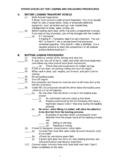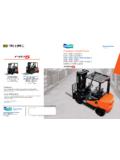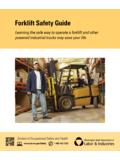Transcription of ENGINEERING STANDARD FOR LAYOUT AND …
1 IPS-E-PR-190. ENGINEERING STANDARD . FOR. LAYOUT AND SPACING. ORIGINAL EDITION. MAR. 1996. This STANDARD specification is reviewed and updated by the relevant technical committee on June 2002. The approved modifications are included in the present issue of IPS. This STANDARD is the property of Iranian Ministry of Petroleum. All rights are reserved to the owner. Neither whole nor any part of this document may be disclosed to any third party, reproduced, stored in any retrieval system or transmitted in any form or by any means without the prior written consent of the Iranian Ministry of Petroleum. IPS-E-PR-190. CONTENTS : PAGE No. 3. 1. SCOPE .. 4. 2. REFERENCES .. 4. 3. DEFINITIONS AND TERMINOLOGY .. 5. 4. SYMBOLS AND ABBREVIATIONS .. 7. 5. 7. 6. SOME KEY ISSUES RELATED TO LAYOUT .. 7. Terrain .. 7. Safety and Environment .. 8. Throughput .. 8. 7. BASIC 8. 8. Blocking .. 8. Location and 8. Prevailing Wind.
2 9. LAYOUT Indication .. 9. Classification of Hazards .. 9. 8. PLANT 9. Area 9. Roadways .. 10. Piperacks and 10. LAYOUT of Control Room and Electrical Sub-Station .. 12. Fire Fighting Requirements .. 13. Building 13. 9. LAYOUT IN PROCESS 13. 13. Process Requirements .. 13. Safety Requirements .. 14. Basic Design Considerations .. 15. Erection and maintenance requirements .. 16. 7 Operational requirements .. 17. Economic 17. Distances/Clearances 17. Equipment LAYOUT and 18. Reactors .. 18. Towers .. 18. Fired 19. Heat exchangers .. 19. Vessels and drums .. 20. 1. IPS-E-PR-190. Pumps .. 20. 20. Storage vessels/tanks .. 21. 10. LAYOUT OF 22. 22. Requirements and Design Criteria .. 23. 11. UTILITY LAYOUT AND 23. Requirements and Design Criteria .. 23. Spacing .. 24. 12. OFFSITE 24. 24. Tank Farm .. 24. Loading and Unloading 24. 13. 25. 14. WASTE TREATMENT 25. APPENDICES : APPENDIX A .. 26. TABLE NFPA CODES, standards AND 26.
3 TABLE CODES AND standards AFFECTING MAINTENANCE REQUIREMENTS 27. TABLE OIA RECOMMENDED SPACING AT REFINERIES, CHEMICALS,PETROCHEMICALS AND GAS PLANTS FOR BUILDINGS .. 28. TABLE OIA GENERAL RECOMMENDATIONS FOR SPACING IN REFINERIES .. 29. TABLE OIA GENERAL RECOMMENDATIONS FOR SPACING IN. PETROCHEMICAL PLANTS .. 30. TABLE OIA GENERAL RECOMMENDATIONS FOR SPACING IN GAS 31. TABLE PROXIMITY OF REFRIGERATED STORAGE VESSELS. TOBOUNDARIES AND OTHER FACILITIES .. 32. TABLE PROXIMITY OF ATMOSPHERIC STORAGE TANKS TO. BOUNDARIES AND OTHER FACILITIES .. 33. TABLE A-9 PROXIMITY OF ATMOSPHERIC STORAGE TANKS TO. EACH OTHERS .. 34. TABLE PROXIMITY OF NON-REFRIGERATED PRESSURE STORAGE. VESSELS/DRUMS TO BOUNDARIES AND OTHER FACILITIES .. 35. 2. IPS-E-PR-190. 0. INTRODUCTION. The STANDARD practice Manuals titled as "Fundamental Requirements for the Project Design and ENGINEERING " is intended for convenience of use and a pattern of follow-up and also a guidance.
4 These STANDARD ENGINEERING Practice Manuals, also indicate the check points to be considered by the process engineers for assurance of fulfillment of prerequisitions at any stage in the implementation of process projects. It should be noted that these Iranian Petroleum standards (IPS), as Practice Manuals do not profess to cover all stages involved in every process project, but they effect the stages that exist in general in process projects of oil, gas and Petrochemical Industries of Iran. These preparation stages describe the following three main phases which can be distinguished in every project & include, but not be limited to : Phase I) " Basic Design Stages (Containing Seven standards )". Phase II) "Detailed Design, ENGINEERING and Procurement Stages (Containing Two standards )". Phase III) "Start-Up Sequence and General Commissioning Procedures (Containing two standards )". The process ENGINEERING standards of this group include the following 11 standards : STANDARD CODE STANDARD TITLE.
5 I) Manuals of Phase I (Numbers 1 - 7). IPS-E-PR-150 "Basic Design Package". IPS-E-PR-170 "Process Flow Diagram". IPS-E-PR-190 " LAYOUT and Spacing". IPS-E-PR-200 "Basic ENGINEERING Design Data". IPS-E-PR-230 "Piping & Instrumentation Diagrams (P & IDs)". IPS-E-PR-250 "Performance Guarantee". IPS-E-PR-308 "Numbering System". II) Manuals of Phase II (Numbers 8 & 9). IPS-E-PR-260 "Detailed Design, ENGINEERING and Procurement". IPS-E-PR-300 "Plant Technical and Equipment Manuals ( ENGINEERING Dossiers)". III) Manuals of Phase III (Numbers 10 & 11). IPS-E-PR-280 "Start-Up Sequence and General Commissioning Procedures". IPS-E-PR-290 "Plant Operating Manuals". This ENGINEERING STANDARD Specification covers: " LAYOUT AND SPACING ". 3. IPS-E-PR-190. 1. SCOPE. This STANDARD Specification covers the basic requirements of the plant LAYOUT and spacing of oil & gas refineries, petrochemical and similar chemical plants to ensure safety and fire prevention together with ease of operation and maintenance.
6 Note: This STANDARD specification is reviewed and updated by the relevant technical committee on June 2002. The approved modifications by were sent to IPS users as amendment No. 1. by circular No. 170 on June 2002. These modifications are included in the present issue of IPS. 2. REFERENCES. Throughout this STANDARD the following dated and undated standards /codes are referred to. These referenced documents shall, to the extent specified herein, form a part of this STANDARD . For dated references, the edition cited applies. The applicability of changes in dated references that occur after the cited date shall be mutually agreed upon by the Company and the Vendor. For undated references, the latest edition of the referenced documents (including any supplements and amendments) applies. API (AMERICAN PETROLEUM INSTITUTE). RP-500 A "Recommended Practice for Classification of Location for Electrical Installation in Petroleum Refineries", Edition Fourth, Jan.
7 1982. API Std. 620 "On Large, Welded, Low Pressure Storage Tanks". API Std. 650 "On Welded Steel Tanks for Oil Storage". ASME (AMERICAN SOCIETY OF MECHANICAL ENGINEERS). "Boilers and Pressure Vessel Codes": - Section I, Power Boilers - Section VIII, Pressure Vessels ASCE (AMERICAN SOCIETY OF CIVIL ENGINEERS). "Minimum Design Loads for Structures". IPS (IRANIAN PETROLEUM standards ). IPS-C-ME-100 "Atmospheric Above Ground Welded Steel Storage Tanks". IPS-E-EL-110 "Electrical Area Classification & Extent". IPS-C-ME-110 "Large Welded Low Pressure Storage Tanks". IPS-C-ME-120 "Aviation Turbine Fuel Storage Tanks". IPS-C-ME-130 "Pressure Storage & Spheres (for LPG)". IPS-E-CE-160 "Geometric Design of Roads". IPS-G-PI-280 "Pipe Supports". IPS-E-PR-360 Process design of liquid & gas transfer & storage . 4. IPS-E-PR-190. IPS-E-SF-200 "Fire Fighting Sprinkler Systems". IPS-C-SF-550 "Safety Boundary Limits".
8 IPS-D-PI-102 "Typical Unit Plot Arrangement & Pipeway LAYOUT ". IPS-D-PI-103 "Pipeline Spacing". ANSI (AMERICAN NATIONAL STANDARD INSTITUTE). ANSI-MSS standards , "Piping Hanger and Supports", 1969 Edition NFPA (NATIONAL FIRE PROTECTION ASSOCIATION). NFPA "Recommendation Codes and standards " (See Table A-1. in Appendix A). NFPA, 59 " STANDARD for the Storage and Handling of Liquefied Petroleum Gases", Ed. 1989. NFPA, 251 " STANDARD Methods of Fire Tests of Building, Construction and Materials", Ed. 1985. IRI (INDUSTRIAL RISK INSURANCE ). "Requirement on Spacing of Flare". TEMA (TUBULAR EXCHANGER MFRS. ASSN. STANDARD ). Uniform Building "From International Conference of Building Office", 1991 Ed. Code, (UBC). - Other referenced standards and code (See Tables A-1 and A-2 in Appendix A). 3. DEFINITIONS AND TERMINOLOGY. Boundary Boundary of the equipment is the term used in a processing facility, by an imaginary line that completely encompassed the defined site.
9 The term distinguishes areas of responsibility and defines the processing facility for the required scope of work. Dike Is an earth or concrete wall providing a specified liquid retention capacity. Diversion Wall Is an earth or concrete wall which directs spills to a safe disposal area. Fire Resistive Fire resistance rating, as the time in minutes or hours, that materials or assemblies have withstand a fire exposure as established in accordance with the test of NFPA 251. 5. IPS-E-PR-190. High Flash Stock Are those having a closed up flash point of 55 C or over (such as heavy fuel oil, lubricating oils, transformer oils etc.). This category does not include any stock that may be stored at temperatures above or within 8 C of its flash point. Low-Flash Stocks Are those having a closed up flash point under 55 C such as gasoline, kerosene, jet fuels, some heating oils, diesel fuels and any other stock that may be stored at temperatures above or within 8 C of it's flash point.
10 Non-Combustible Material incapable of igniting or supporting combustion. Ordinary (See Table in Appendix A). General masonry walls with wood roof and/or wood floors; also all frame construction. Pipe Rack The pipe rack is the elevated supporting structure used to convey piping between equipment. This structure is also utilized for cable trays associated with electric-power distribution and for instrument tray. Plot Plan The plot plan is the scaled plan drawing of the processing facility. Sheathed Incombustible or Incombustible (See Table ). Wood frame, incombustible sheathing. Sleepers The sleepers comprise the grade-level supporting structure for piping between equipment for facilities, , tank farm or other remote areas. Tank Diameter Where tank spacing is expressed in terms of tank diameter, the following criteria governs: a) If tanks are in different services, or different types of tanks are used, the diameter of the tank which requires the greater spacing is used.


